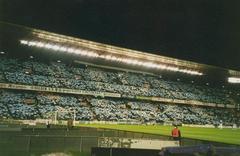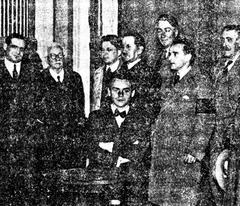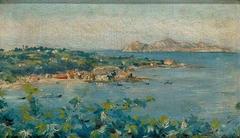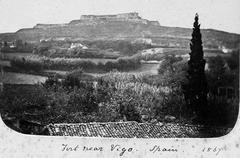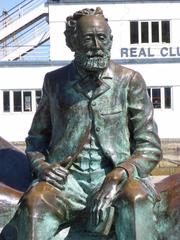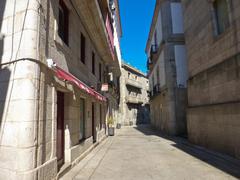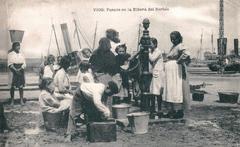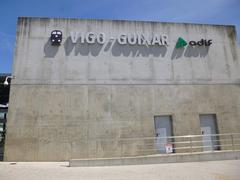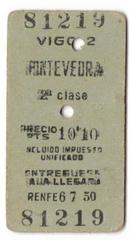Cruceiro De Capela Das Travesas De Vigo: Visiting Hours, Tickets, and Travel Guide
Date: 14/06/2025
Introduction: History and Cultural Significance
The Cruceiro De Capela Das Travesas stands as a prominent testament to Galicia’s enduring spiritual and artistic traditions. Situated in Vigo, Spain, this stone cross (cruceiro) is not only a symbol of religious devotion but also a vivid reminder of the region’s medieval and modern cultural identity. Cruceiros like this one—especially those of the “capela” typology, featuring a chapel or niche beneath the cross—have been central to Galician communities since the Middle Ages, serving as markers for crossroads, places of prayer, and protection for travelers. Their proliferation was particularly encouraged following the 16th-century Catholic reforms (Galicia Slow Travel, Guía Galicia).
Located on Avenida de Castelao in the lively As Travesas neighborhood, the monument not only intersects Vigo’s urban rhythm with Galician religious tradition, but also commemorates the intellectual legacy of Daniel R. Castelao, an esteemed Galician scholar. The Cruceiro’s location along the Camino Inglés pilgrimage route and proximity to landmarks like the Capela de San Roque and As Travesas Market make it a significant stop for pilgrims, historians, and cultural travelers alike (Xose Counhago, Pilgrimage Traveler).
Guide Contents
- The Cruceiro De Capela Das Travesas: Why Visit?
- Historical Background of Galician Cruceiros
- Unique Features of the Capela Cruceiro
- Practical Visitor Information
- Location & Access
- Visiting Hours
- Admission
- Accessibility
- Best Times to Visit
- Nearby Attractions
- Guided Tours & Special Events
- Artistic Features & Iconography
- Rituals, Legends, and Local Importance
- Preservation Efforts
- Frequently Asked Questions (FAQ)
- Visual Resources
- Conclusion and Further Reading
The Cruceiro De Capela Das Travesas: Why Visit?
As one of Vigo’s most distinctive monuments, the Cruceiro De Capela Das Travesas is a must-see for anyone interested in Galician history, art, or spirituality. It offers insight into centuries of faith and craftsmanship, standing as both a spiritual landmark and a work of public art.
Historical Background of Galician Cruceiros
Cruceiros are emblematic stone crosses found throughout Galicia, with origins tracing back to the 14th century (Galicia Slow Travel). Originally erected by monastic communities, they became widespread after the Council of Trent in the 16th century, as part of efforts to sacralize public spaces. Today, over 12,000 cruceiros dot the Galician landscape, serving as enduring markers of popular devotion and local artistry (Guía Galicia).
Unique Features of the Capela Cruceiro
The “cruceiro de capela” is characterized by a small shrine or niche beneath the cross, often housing Marian imagery or religious bas-reliefs. The Cruceiro De Capela Das Travesas exemplifies this style, featuring:
- Base and Shaft: Decorated with symbolic motifs, including an open book referencing Castelao’s scholarship and prehistoric engravings (Xose Counhago).
- Chapel/Niche: Houses intricate carvings of the Virgin Mary, Santiago Matamoros, and Saint Francis.
- Cross: Adorned with a crucified Christ on the front and a Pietà on the reverse, evoking medieval and Franciscan influences.
This combination of religious iconography and artistic detail highlights the monument’s dual role as a spiritual and cultural landmark (Xose Counhago).
Practical Visitor Information
Location & Access
- Address: Avenida de Castelao, As Travesas, Vigo, Galicia, Spain
- Public Transport: Served by several city bus lines; nearest stop is As Travesas (Casa Avelina), just steps away (Moovit).
- On Foot: The monument is directly on the Camino Inglés route; signage guides pilgrims and visitors.
Visiting Hours
- Monument: Accessible 24/7 as it is an open-air public site.
- Capela de San Roque: Usually locked; key available upon request at Bar Avelina across the street.
Admission
- Cruceiro: Free, no tickets required.
- Chapel: Free, but donations for upkeep are customary.
Accessibility
- Physical Access: Paved, generally flat terrain; wheelchair accessible. Some uneven surfaces may exist nearby.
- Facilities: Restrooms and refreshments available at Bar Avelina; additional amenities at As Travesas Market (Turismo de Vigo).
Best Times to Visit
- Photography: Early morning or late afternoon for optimal lighting.
- Atmosphere: Weekdays or off-peak hours for a quieter experience.
Nearby Attractions
- As Travesas Market: A vibrant local marketplace (Turismo de Vigo).
- Praza de América: A central plaza with shops and cafes.
- Castro das Travesas: Site of ancient hill fort remains (Pilgrimage Traveler).
- Museum of Contemporary Art (MARCO) and Vigo’s historic old town.
Guided Tours & Special Events
Local tourism offices and cultural institutions sometimes offer walking tours that include the Cruceiro De Capela Das Travesas. During religious festivals or Holy Week, the cruceiro may serve as a focal point for processions and community gatherings. Check with the Vigo Visitor Reception Centre for schedules.
Artistic Features & Iconography
- Base: Features Castelao’s “As cruces de pedra na Galiza” and prehistoric motifs.
- Chapel (Capeliña/Fornelo): Three-sided, with bas-reliefs of the Virgin, Santiago Matamouros, Christ, and a Franciscan friar.
- Cross: Depicts Christ crucified and Marian imagery, reflecting traditions of the “Virxe de Loreto” cruceiros (Xose Counhago).
Rituals, Legends, and Local Importance
Cruceiros are often associated with Galician legends, such as the Santa Compaña (a ghostly procession), and serve as sites for prayer, offerings, and remembrance (Galicia Slow Travel). In Vigo, the monument links the modern city to rural spiritual traditions, fostering a sense of community and continuity.
Preservation Efforts
Urban development and environmental exposure pose challenges to the preservation of cruceiros. The Travesas monument, surrounded by city infrastructure, underscores the need for ongoing conservation, improved signage, and public awareness (Xose Counhago).
Frequently Asked Questions (FAQ)
Q: What are the visiting hours?
A: The cruceiro is outdoors and accessible at all times.
Q: Is there an admission fee or ticket required?
A: No, visiting the cruceiro is free. Donations for chapel maintenance are welcome.
Q: How do I access the Capela de San Roque?
A: Request the key from Bar Avelina. Please leave a small donation.
Q: Is the monument accessible for people with disabilities?
A: Yes, the area is generally wheelchair accessible with paved sidewalks.
Q: Are guided tours available?
A: Local guides and pilgrim groups occasionally organize visits; check with the Vigo Visitor Reception Centre.
Q: What else can I see nearby?
A: As Travesas Market, Praza de América, Castro das Travesas, and Vigo’s historic old town.
Visual Resources
All images are from Wikimedia Commons and illustrate the monument’s sculptural program.
Conclusion and Call to Action
The Cruceiro De Capela Das Travesas is more than a historic stone cross—it is a living symbol of Galician artistry, community, and faith. Its accessible location, rich iconography, and cultural resonance make it a must-visit for anyone exploring Vigo or the Camino Inglés. Whether you are a pilgrim, art lover, or traveler, this monument offers a rewarding connection to Galicia’s past and present.
Enhance your journey by downloading the Audiala app for interactive guides, visit the Vigo Visitor Reception Centre for the latest information, and follow our social media channels to discover more about Galician heritage.


